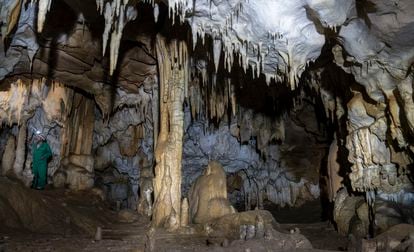The narrow CA-1 road that winds up from Poncebos Bridge It runs parallel to the Duje River, avoiding small tunnels dug into the rock. The wind blows strong up in the mountains, the clouds go fast and when they withdraw for a few moments you can see the snow-capped peaks of the central and eastern massif of the Picos de Europa. The sound of the cowbells joins the sound of the river, it is a herd of cows planted so calmly in the middle of the road. “They are casinas” says Juanjo, our guide, native mountain cows from Asturias that even in winter roam freely grazing, up the meadow, down the meadow. And it is that here all the animals graze freely, sheep, goats, cows…, even donkeys and dogs are on the loose.
Paradise for hikers, climbers, demanding palates or those who simply seek nature in its purest state; For all of them, the Asturian corner of Picos de Europa is the perfect destination for any time of the year.
Sotres, in the heights
We arrive at the highest town in Asturias, Sotres (1,050 meters), to stay in Cyprian House, a family hotel whose owners, Juanjo and Sonia, are pioneer mountain guides in these lands, know every corner of the national park and the people who inhabit it. To get an idea of the enclave of the town there are several viewpoints: Narayo with two benches nailed to the rocks and wonderful views of Las Vegas de Sotres and the Picos, Sierra Mor recreational area or the winterlings of Texua group of cabins of popular architecture.
Bulletin
The best recommendations for travel, every week in your inbox
RECEIVE THEM
The most expensive cheese in the world
Our first date is with Jessica López, from the main cheese factory, in Sotres de Cabrales. She has been making Cabrales cheese for 16 years and has been the president of the Cabrales Cheese Denomination of Origin Regulatory Council. This is where the most expensive cheese in the world sold at auction came from, according to the Guinness Book of Records, when in 2019 a two-kilo piece made in the town of Tielve reached the beautiful sum of 20,500 euros. López tells of the production process: the only 37 caves in which Cabrales is produced, how the cheeses are cleaned with the water that filters through the cracks in the rocks or the degrees to which the cave must be for its correct preparation (less than 13°C). But what is most impressive is how each piece is transported to the caves in backpacks on the back, with mules and, on rare occasions, by helicopter. “Every week you have to go to the cave to wash them or they would spoil,” he explains. “And when it snows?” I ask. “The same, we leave the door of the cave open and we dig the path with the shovel hanging from the tree, the same one that indicates where the entrance is.” The visits to the caves conclude, of course, with a tasting of cabrales.
Posted by Cheese Main Cabrales Cheese on Wednesday, January 11, 2023
Kneading the ‘dielda’
We got on the jeep on the way to the Vegas de Sotres. Here Deli López awaits us, who has already turned on the wood oven and is kneading the dielda, What is the sourdough of bread called around here? While she rests, she remembers when she had 12 cows, 30 sheep, 10 goats and three girls to take care of while her husband worked in the Las Mánforas mines, in the Aliva meadows; or looking back even further, when she made bread with her mother for the whole week and they sent her with a piece of it covered in cream to take care of the cattle. She tells everything with a smile on her face, the one that makes her spend long periods of time in this cabin without electricity or water surrounded by mountains, meadows and shepherds. After resting for an hour and a half, the dough is ready to go into the oven and become a delicious loaf that we will try during dinner.
Walks in Bulnes
He bulnes funicular, which has been operating since 2001, it takes seven minutes to cover the little more than two kilometers excavated in the Peña Maín that separates Poncebos from Bulnes. This funicular marked the end of a fight that the residents of Bulnes had been fighting for years; almost everyone preferred a road, but the funicular has been equally welcome and is a relief for the 27 residents who live there today. This small town, on the banks of the Tejo River, is one of the most beautiful in Asturias and maintains all its charm even though things have changed. Until a few years ago here you could only spend the night in the Villa de Bulnes Hostel, but now the offer has grown and there are several rural accommodations suitable for all budgets. To eat we go to the first restaurant in town, the Bulnes Baropened in 1974 by the forest ranger Marcelino Mier, now run by his descendants.
Many trails lead to Bulnes, the busiest starts from Puente Poncebos and ascends the Canal del Tejo in an easy walk of an hour and a half. In addition, countless excursions depart from the town throughout the national park, which has a wonderful network of mountain lodges where you can spend the night and eat.
The Comprehensive Travesera de Picos
There are several routes in 4X4 within the Picos de Europa National Park. One of the most interesting is the one that goes from Poncebos (Asturias) to the Leonese town of Posada de Valdeón; You can walk a section of the famous Cares path and make your way back by car. It takes the same time, about three hours, but here we will see all the massifs that make up the park and we will have a more global idea of it.
Another impressive experience, but not suitable for everyone, is the Peaks Comprehensive Traveseraone of the toughest mountain races in the world (74 kilometers and 6,560 meters of unevenness in a single day), which in 2023 will be held on June 10 (although the registration period is already closed).
The picture of Pico Urriellu
From Puente Poncebos we go up the road that takes us to the village of CamarmeñoWhere is he Urriellu Peak viewpoint (Orange tree of Bulnes). If you are not willing to climb the 1,190-meter drop in a 12-kilometre path from Sotres or the 1,960-meter drop from Puente Poncebos, at least from this point, on a clear day, you can get a photo of that incredible block. limestone of 2,519 meters.
Explore the Pando cave

Jose Andres Blancowinner in the cycling modality of the Sydney 2000 Paralympic Games, is the guide of the pando cave (Ribadesella) for 35 years. This cave in the shape of a number nine, full of stalactites and stalagmites, is as beautiful as it is easy to walk through, a good start for caving. It can be visited with children, whom José makes enter tunnels only suitable for their small bodies, crawling out through another unsuspected hole in the wall. All this if we manage to pass the filter of its narrow sloping entrance, with which not everyone dares.
In the lakes of Covadonga
We change area and go to one of the best-known points of the national park: the glacial lakes of Enol, Ercina and Bricial, better known as the Covadonga lakes, at an altitude of 1,134 metres, in the council of Cangas de Onís. Out of season they can be accessed by car, and several trails of different degrees of difficulty start from there. In Enol, a rather peculiar rite is carried out: every September 8, since 1972, divers raise an image of the Virgin, created with the remains of rifles, which rests in a cave at the bottom of the lake for the rest of the year. .

And back in Sotres, as night falls, the pounding of Abel Fernández’s hammer is heard tuning the cowbells in his workshop. The goats passed a while ago along the main street on their way to the lower meadows and predicting those flakes of snow that will cover the town and everything in sight in white for several months.
Subscribe here to newsletter of The Traveler and find inspiration for your next trips in our accounts Facebook, Twitter and instagram.
#route #Picos #Europa #leaving #Asturias


/cloudfront-eu-central-1.images.arcpublishing.com/prisa/KV5KT65UHJMX3XNFP5SMSFDKGI.jpg)






